





PHOTO GALLERY

Photos by Len Blumin
1. Common Goldeneye and Barrow's Goldeneye
The Common Goldeneye really is more common than the Barrow's, at least in the SF Bay Area, and most of the lower 48. Barrow's Goldeneyes tend to be mainly coastal, and more in the northern states. Here we see perhaps one Barrow's for every 50-100 Common, roughly similar to the ratio of Eurasian/American among the Wigeons. Best areas for Goldeneyes are Black John Slough in the North Bay (east Marin) and Lake Merrit in Oakland.
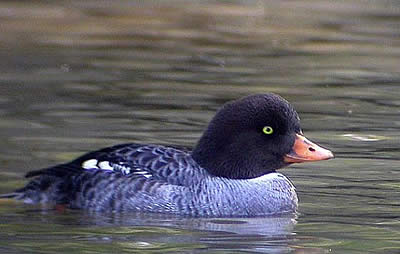
Shown below are Goldeneye females from the same Lake Merrit outlet as before (10th Ave). If you go there take a friend, as the neighborhood is not upscale. Anyway, the ducks were swimming in partial shade, giving exposures of about 1/40 sec, which makes for less than sharp pics. But the closeness of the views is fantastic to study these fine ladies up close. The Barrow's Goldeneye is on top. Note the almost completely orange bill, and how the bill seems shorted and thicker when compared to the Common Goldeneye females below. The forehead slopes seem similar in these photos. Barrow's head held low and forward, which is said to be characteristic.
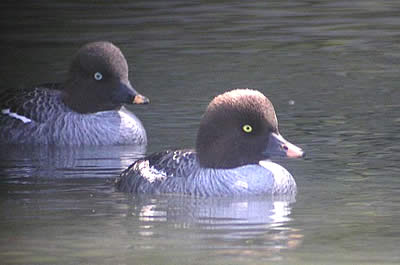
2. Goldeneye Postures
According to Milton Weller (Sibley Guide to Bird Life & Behavior), the sea ducks are a tribe called Mergini, including 9 different genera and a total of 19 species. They all dive, and can be seen in coastal waters. We are especially lucky in North America, as 15 of the 19 species world-wide are seen here, including the Scoters, Eiders, Goldeneyes, Bufflehead, Mergansers, Harlequin and Long-Tailed Ducks.
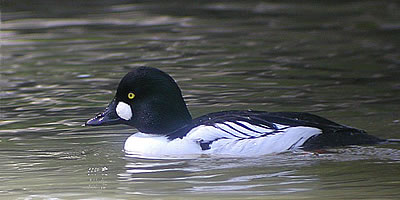
The genus Bucephala (Ox-headed, or Buffalo-headed) contains only three species, all seen locally. In fact we saw all three swimming in the same outlet channel of Lake Merrit (Oakland, CA), just north of 10th St and just east of the Kaiser Convention Center. The Bufflehead is not in this photo, but we can see the Common Goldeneye male (Bucephala glangula) in 2 very different modes. On top he is just swimming along and relaxing. These birds are almost always in motion! Below he has yielded to the charms of a group of female Goldeneyes, and in fact seems particularly interested in a Barrow's Goldeneye (Bucephala islandica). Not only is his necked extended, but he has even changed his head's shape by erecting the feathers on the crown! How can she resist? See below for more.
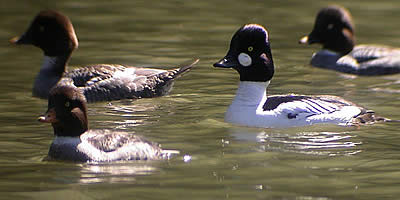
Well, Rich Stallcup always says, when the bird looks different than the drawing in the book, always take the bird! Top photo shows the male with head low and forward-leaning, which is supposed to suggest a Barrow's. The bottom photo shows a nice purple sheen, which is said to be more common in the Barrow's male. The lowest female Goldeneye here appears to be a Barrow's, with a shorter all-yellow bill and a steeper slope to the forehead.
3. Tufted Duck
Back to the pochards, or diving ducks. This one is a regular "visitor" to the west coast. One of the Eurasian species in the Aythya genus, the Tufted Duck, Aythya fuligula, is seen just about every year in the Bay Area, usually in 3-5 locations. The male Tufted has a white flank like a Scaup, but is easily picked out from a group of Scaup by the deep black on his back. He also looks a lot like the Ring-necked duck, but lacks the white ring at the base of the bill, and the white flank lacks the sharp spur at the front that we see in the Ring-necked. Oh, did I forget the tuft? Well, we don't always see the tuft, which is also present in the female, so it is nice to remember the other field marks.
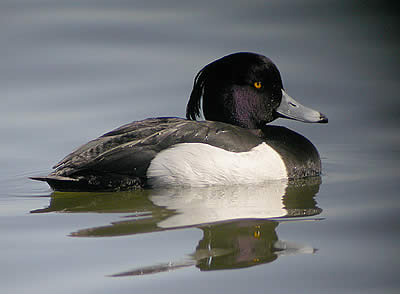
This particular male has a very long tuft, which touches his back when the neck is relaxed, as here. The purple sheen on the head is of course variable, depending on the light. Bright sunlight at Berkeley's Aquatic Park this morning made for a good sheen, but created other problems for digital capture. We can thank Joe Morlan for alerting us to the continuing presence of this one at Aquatic Park. It was swimming back and forth in the main pond, along the east shore, about 1/3 up from the south end. Very relaxed bird, even ignoring the scullers as they rowed by.
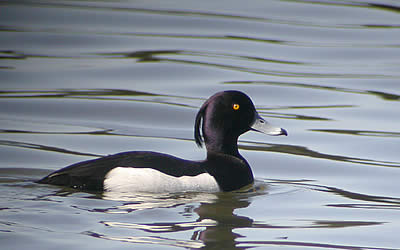
Something seems to have alerted our duck, as he extends his neck and looks around. The water looks nice in this shot, and the purple sheen glows to show how handsome he is. The nearby female Scaups (probably lesser, but didn't check) seemed unimpressed. Tufted Ducks are known to hybridize with both Scaups and Ring-Necked Ducks, but I suspect they do not form pair bonds until they return to their breeding grounds way up north.
4. Burrowing Owl
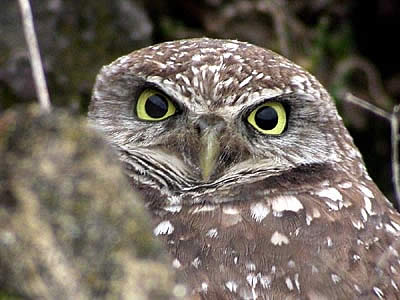
There are two Burrowing Owls wintering on the riprap along the Jean and John Starkweather pathway in San Rafael. A small quiet group of birders will probably not disturb them, but I do not plan to advertise their presence further. Marin Audubon Society is working quietly to ensure that these lands ("Canalways") are not developed. Contact Jean, Lowell Sykes, or Barbara Salzman if you want to help. The presence of these endearing birds, along with the obvious wetland nature of the substrate, will hopefully carry the day. It is a fantastic opportunity to restore tidal wetlands in an urban setting. Conditions not great for a photo, but here is one of them giving me the "I'm watching you..." look.
5. Merlin

Merlin at Land's End, San Francisco, March, 2006.
TOWHEE.NET: Harry Fuller, 820 NW 19th Street, McMinnville, OR 97128
website@towhee.net